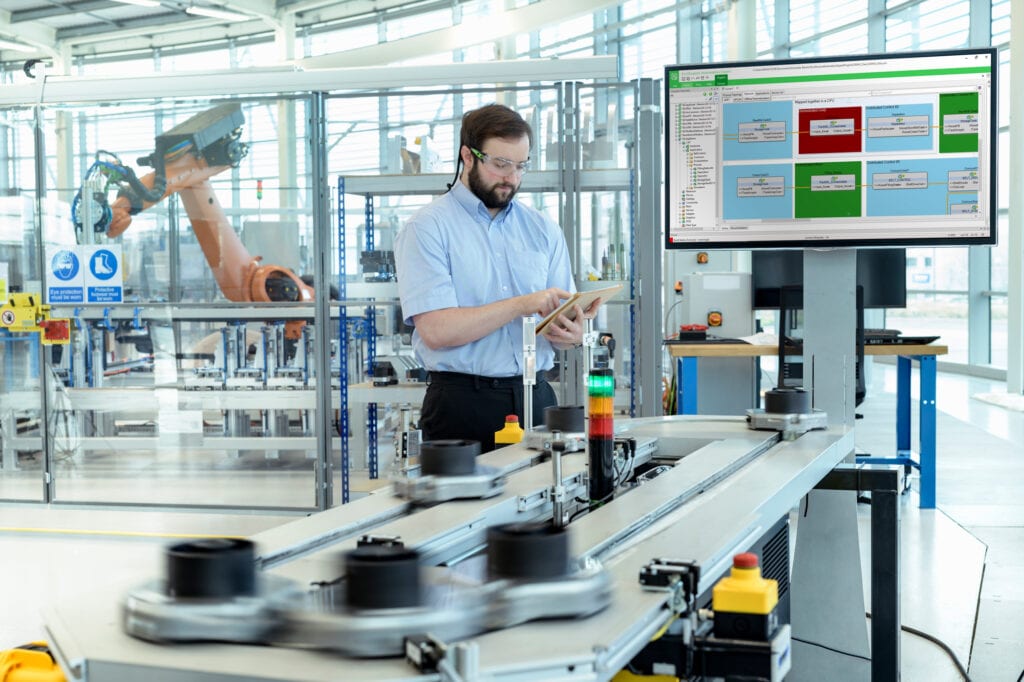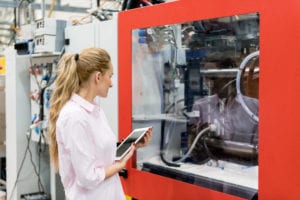
We cannot afford to miss this opportunity to use software-centric and data-driven automation to make meaningful change.
- The industrial sector is dominated by closed, propriety systems that are not designed for flexibility and prioritize vendor lock-in over innovation.
- Failure to apply truly open, interoperable standards for automation tools is costly on all fronts and bold action is needed now to recover from COVID-19.
- Change will only be achieved through global collaboration and we call on the entire industrial ecosystem to come to the discussion table for universal automation.
As the world strives to recover from the pandemic, industry has a golden opportunity to become a central pillar of global economic recovery. So, what will it take to get us there?
Even before the pandemic, industrial productivity growth was moving in the wrong direction – and lingering at just 0.7%. In Q2, amid the global shutdown, global manufacturing output dropped by 11.1%, only recovering somewhat in the second half of the year.
If we’ve learned anything from the disruption caused by COVID-19, it’s that agility and resiliency are essential to modern industry. To see genuine changes in efficiency and sustainability, we need to make bold moves now.
Open is not enough
The industrial sector is ripe for disruption. It is dominated by closed, propriety systems that are not designed for flexibility and prioritize vendor lock-in over innovation. On the surface, many automation suppliers talk about “open” technology. However, open automation as it exists today is not open enough, as many suppliers have yet to embrace vendor-agnostic systems, where software from one vendor can run on hardware from another. As a result, industrial enterprises endure unnecessary engineering expense and delays in rolling out innovation. The consequence is reduced agility and lost business opportunities.
Even before the pandemic, industrial productivity growth was moving in the wrong direction.
Image: UN Industrial Development Organization
Failure to apply truly open, interoperable standards for automation tools is costly on all fronts. It’s a ubiquitous challenge that is holding industrial operations back across the world. It’s in everyone’s interest – from vendors, original equipment manufacturers (OEMs) and machine builders to systems integrators and end users – to find a way through the impasse. Ultimately, like many of today’s biggest challenges, it can only be achieved through collaboration.
The price of inertia
By keeping technology built on closed, proprietary systems, we are stunting innovation, while crippling productivity from “teamwork” between systems, machines and people. We can no longer accept needlessly big engineering efforts, a lack of modularisation or any barriers to resilience and innovation.
A group of co-workers who cannot communicate cannot be productive. Today’s closed automation systems encounter the same difficulties. They can’t simply integrate or collaborate with third-party devices, nor can they be easily upgraded.
In the current paradigm, industrial businesses and workforces continue to be held back by closed and proprietary systems, hampering the highest priority areas, namely innovation, efficiency, sustainability and agility. We are left with an under-optimized sector, propped up by a damaged global economy.
Industrial crossroads
We’ve reached an inflection point. Current industrial automation system architecture has done a good job of advancing industry to where we are today, but to realize the full promise of the Fourth Industrial Revolution we need to fundamentally change our technology model.
We now have the computational power and levels of connectivity necessary to overhaul industrial sustainability and operational eco-efficiency. And with the environmental clock running out, we can’t afford to miss this opportunity to use software-centric and data-driven automation to make meaningful change.
An alternative future is bright. According to Accenture, by 2030 the Industrial Internet of Things (IIoT) could not only add trillions to the global economy but also increase productivity and efficiency for manufacturers worldwide. A World Economic Forum report in collaboration with Boston Consulting Group (BCG) has suggested that 72% of manufacturers see advanced analytics as increasingly important, while 80% believe increased productivity can be achieved through digitalization and data-driven insight.
Universal automation
Just as the IT world has embraced the benefits of open-operating platforms, now it’s industry’s turn. Universal automation is the world of “plug and produce” automation software components that solve specific customer problems in a proven way. Think of it as the dawn of an industrial automation app store. The technology already exists to make it possible. The IEC 61499 standard for interoperable and portability can be used to create a standardized automation layer across vendors, similar to the way that the Linux open source operating system helped standardized operating systems across computers.
By removing technology barriers, universal automation allows manufacturing lines and industrial processes to be quickly reprogrammed by engineers as required, even remotely. This heightened agility and productivity is necessary to cater to shifting consumer demand patterns, while also accommodating the limitations brought on by the pandemic.
Plug and produce industrial automation
The adoption of the IEC61499 standard for interoperability and portability alleviates many challenges facing industry today. Adoption of a common standard across vendors ensures different hardware and software systems can leverage advanced technologies by communicating with each other.
Universal automation eliminates many of the pain points of automation adoption. New technologies can be introduced, upgraded and integrated without wasting time and resources for refactoring. By utilizing cybersecure IT architectures and technologies natively within a robust automation infrastructure, manufacturers can integrate advanced data-driven applications easily.
The interoperable system also has great potential for maintenance and efficiency. With a single, open and heterogenous automation system, maintenance engineers can rapidly find and fix faults and incorporate innovative maintenance technologies to avoid issues. This includes proactive and predictive maintenance – the process of repairing a plant asset before it fails. This type of maintenance lowers risk, minimizes unplanned downtime and helps address small faults before they become expensive systematic failures. Indeed, predictive maintenance saves roughly 8% to 12% over preventive maintenance and up to 40% over reactive maintenance.
A different future is within reach. With universal automation, we can achieve intelligent automated operations with production lines attaining self-configuring and self-healing capabilities.
No one can do it alone
The first step towards achieving this new industrial productivity and efficiency is collaboration. We call on the entire industrial ecosystem to come to the discussion table for universal automation. Before any meaningful change can happen, we must build trust, remove adoption barriers, identify new ways to share data and continue innovating using a standardized approach. Only by committing to advance next-generation industrial technology together, can we all share in a better reality for our industries of the future, our people and our planet.
Join the conversation on Schneider Electric Exchange.
Co Authored By:



